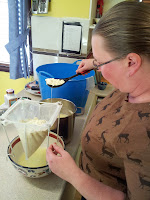Writer: Alex
Participants: Alex, Clare
Items: Milk, Flax as Linen
The Mad Millie hard cheese
kit came with this recipe for Asiago. Having checked against other recipes
(Carroll, CheeseTV) there are some specific discrepancies which are not
reflected in either of these batches (having found them after making the
cheese).
Discrepancies:
According to some sources
(CheeseTV, various websites) asiago is a brined cheese which is waxed. This
recipe does not require you to do either.
Asiago is a town in the
Vicenza province of Italy. It is a
protected Designation of Origin cheese, which means only true asiago cheese can
be produced there. It is a high alpine pastured cheese, originally produced
using sheep milk.
Asiago is an unpressed hard
cheese, which means that it can be moulded into a number of shapes. It is often
used as a substitute for parmesan because of its similar sharp taste, and it's
aging time is much quicker (3months compared with parmesans 2years). The
flavour of Asiago is indicated through the colour of the wax; Clear or White =
mild (1-2 months), Brown = medium (2-6 months) and Black = aged (6-12 months).
|
Equipment
Large pot or water bath
Slotted spoon
Metal whisk
Cheese thermometer
Fine muslin cheese cloth
(or linen)
Cheese mould
Cheese mat
|
Ingredients
6Lt pasteurised,
unhomogenised cows milk
1/4 packet of Thermophilic
starter culture
2 tablets of rennet
(vegetarian in this case)
1/4 cup of unchlorinated
spring water
3ml calcium chloride
1 tbsp of cheese salt
|
Method
- slowly heat milk to 32oC (around 30mins)
- add calcium chloride
- add starter culture and stir slowly from top to bottom for 1 minute
- cover and leave to rest for 30minutes
- dilute the rennet in the spring water making sure it is thoroughly dispersed
- maintaining a temperature of 32oC, add rennet to milk
- stir slowly for 1minute
- maintaining a temperature of 32oC, cover and sit for 1hour (or until a clean break)
- cut the curd into 5mm cubes
- stir with a metal whisk to make sure the curds break into even sized pieces
- heat slowly to 38oC over 30minutes
- let the curd rest at 38oC for 40 minutes
- line your cheese mould with the muslin
- gently scoop the curd into the mould using a slotted spoon to remove as much whey as possible
- press firmly into the mould with your hands
- cover with muslin and leave to drain overnight (16hours)
- gently remove the cheese from the mould and undress
- salt top and bottom surfaces and place cheese on cheese mat
- keep at 16oC turning the cheese every other day
- if mould forms, wipe the surface with a piece of muslin dipped in the brine solution
- a rind should form in 3-4weeks
- keep turning the cheese every other day until mature (2-4months)
Specific Photos
Large round aged and waxed
Moulded heart aged and waxed
The failed round. You can
see where the mould worked its way into the pitting around the edges.
Notes
- The initial temperature was easily achieved, however we had trouble with the second rise where the temperature stubbornly stayed at 42oC.
- The first batch of asiago was very soggy and I ended up salting it twice to help draw out the liquid. It needed to sit on a cheese mat over a tray to collect the excess moisture for a week and a half.
- When the discrepancies between this recipe and others was discovered it was decided that we would wax this cheese as the others call for. At that point it was too late to brine the cheese as the rind was already in the process of forming anyway. In any future attempts at this cheese I will look at including the brining process.
- Whilst the setting milk was overheated, the temperature was still in the working range for the thermophilic starter. So there should be little impact on the final product.
- Two sets of Asiago were made. The first was firmly pressed into the mould, the second not as firmly. The second set of cheese (one heart shaped and one round) were a nightmare to keep clean and eventually the second round simply failed due to the amount of mould growth. Because the round wasn't as firmly pressed into the mould, the sides had ragged edges which allowed mould to grow and made it very, very difficult to properly clean. This failed round has been saved to be used as part of the cheese glue process because the mould should not pose too much of a problem, unless you eat paste...
















